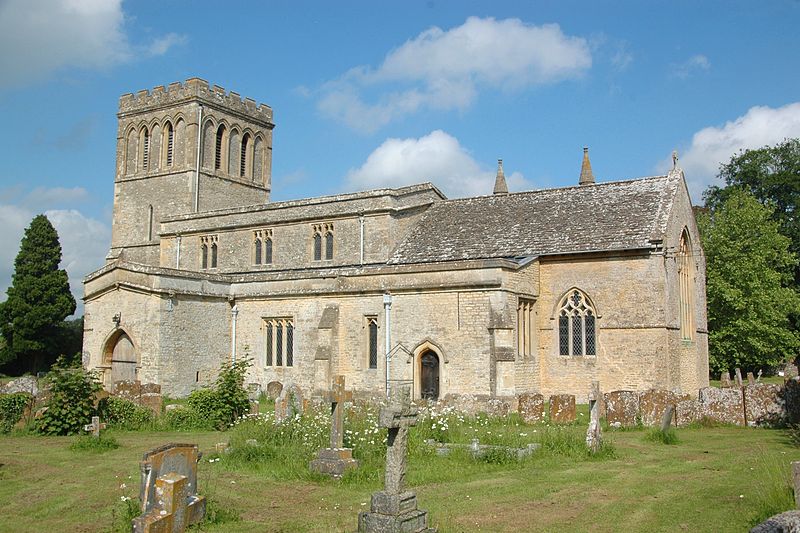Arthur Mee - The King's England, Oxfordshire.
Middleton Stoney – The Adventures of a Font.

The church is embowered in magnificent trees, two tremendous cedars rising above the beautiful 700-year-old tower. The north doorway is 13th century, with foliage capitals and a carved head, and the spacious south porch with a deeply moulded arch has a Norman doorway, with five rows of chevron, two grotesque heads, and a tympanum with a crude tree of fruit and foliage, a wonderful representation of the Tree of Life. The nave has a Norman arcade with arches on round pillars and square capitals, and the chancel arch is 13th century with carving in the mouldings and clusters of shafts under deeply cut leafy capitals. The chancel is Norman, the walls having carving inside and out, and a modern arch in Norman style opens from it to the Jersey chapel. There is a portrait brass in the chancel of Elizabeth Harman, showing her in the hooped skirt and pointed bodice she wore in Queen Elizabeth’s day. The battered 14th century font has had a series of adventures, beginning its career in the old King’s Chapel at Islip, passing from there to a farmer who used it as a bowl for feeding the turkeys, then becoming a washing bowl, and finally doing service as a garden ornament before it returned to a place of dignity worthy of its age and beauty.
W. Hobart Bird – Old Oxfordshire Churches.
The church of All Saints is in very beautiful surroundings in the park has quire, clerestoried nave, aisles, West tower, South porch and a modern mausoleum. The tower is of four stages, a good and perfect example of Early English. It has the original stringcourse to each stage and lancet lights on the third stage. The upper has double sound-holes with continuous mouldings to the arches, cylindrical pillars and moulded capitals. The labels continue above each arch and along the wall. The parapet is later.
The large South porch has a good Early English doorway with typical jamb-shafts and moulded capitals, plain abaci, and one roll-mould to the arch. The inner doorway is ornate Norman. The jambs have two receding orders of chevron with plain abaci and an arch of five chevron orders. The interesting sculptured tympanum has conventional branching ornament. It is a fine example of a pure Norman doorway.
The quire retains the original Norman stringcourse with saw-tooth ornament. It is interrupted by late 13th-cent. Decorated lights. On the East external wall are two “head” corbels or image brackets and another on the North wall. On the East wall of the transept is a blocked Early English lancet light. The Norman string reappears on the North wall of the transept (reused). The small North doorway is good Early English with stiff-stalk capitals and moulded bases to the jamb-shafts. The round arch has a inner roll-mould and label with a mask in the centre and grotesque finials. The large quire has on the East a five-light Decorated geometrical window, on the North a round-arched light in a deep splay, and South a three-light Decorated.
There is a piscina, and modern arch to the North chapel. The chancel arch is a fine example of Transitional Early English work. It has compound responds with curiously sculptured capitals and the pointed arch has an inner order of dog-tooth ornament between two roll-moulds plain, and a label. The nave arcade is of three bays North and South. The North is good Transitional Norman. The cylindrical pillars have moulded bases and the square capitals have varied foliate ornament and massive pointed arches of similar style to the chancel arch. The clerestory lights are Perpendicular. The South arcade has two bays of Decorated work, with octagonal pillars and capitals, and one (East) has plain masonry.
Note the very fine Decorated octagonal font with arcaded panels of beautiful tracery. It is sadly perished, doubtless from standing out of doors for many years. The inscription on it is in part obviously unreliable, although doubtless it may have come from the King’s chapel at Islip. The Early English tower arch has moulded responds and a chamfered arch of two orders. There is a small piscina at the end of the South aisle and two Perpendicular windows. In the park, near the churchyard, is the base and stem of an old wayside or churchyard cross.